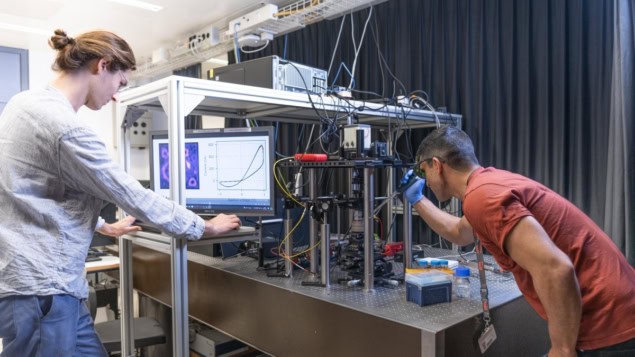
A memristor that uses changes in ion concentrations and mechanical deformations to store information has been developed by researchers at EPFL in Lausanne, Switzerland. By connecting two of these devices, the researchers created the first logic circuit based on nanofluidic components. The new memristor could prove useful for neuromorphic computing, which tries to mimic the brain using electronic components.
In living organisms, neural architectures rely on flows of ions passing through tiny channels to regulate the transmission of information across the synapses that connect one neuron to another. This ionic approach is unlike the best artificial neural systems, which use electron currents to mimic these synapses. Building artificial nanofluidic neural networks could provide a closer analogy to real neural systems, and could also be more energy-efficient.
A memristor is a circuit element with a resistance (and conductance) that depends on the current that has previously passed through it – meaning that the device can store information. The memristor was first proposed in 1971, and since then researchers have had limited success in creating practical devices. Memristors are of great importance neuromorphic computing, because they can mimic the ability of biological synapses to store information.
In this latest research, EPFL’s Théo Emmerich, Aleksandra Radenovic and their colleagues made their nanofluidic memristors using a liquid blister that expands or contracts when currents of solvated ions flowed into or out of it, changing its conductance.
Iconic and ionic
In 2023, researchers took a significant step toward ion-based neuromorphic computing when they discovered memory effects in two nanofluidic devices that regulated ion transport across nanoscale channels. When subjected to a time-varying voltage, these devices displayed a lagging change in current and conductance. This is a memristor’s characteristic “pinched” hysteresis loop. However, the systems had weak memory performance, and were delicate to fabricate. Furthermore, the mechanism responsible for the memory effect was unclear.
But this has not deterred the EPFL team, as Emmerich explains: “We wanted to show how this nascent field could be complementary to nanoelectronics and could lead to real-world computing applications in the future”.
To create their device, the EPFL researchers fabricated a 20 micron-by-20 micron silicon nitride membrane atop a silicon chip, with a 100 nm-diameter pore at its centre. On this chip, they deposited 10-nm-diameter palladium islands around which fluid could flow, by using evaporative deposition techniques. Finally, they added a 50–150 nm thick graphite layer, to create channels that led to the pore.
Tiny blister
Upon dipping the device into an electrolyte solution and applying a positive voltage (0.4–1.0 V), the researchers observed the formation of a micron-scale blister between the silicon nitride and the graphite above the central pore. They concluded that ions travelled through channels and converged at the centre, increasing pressure there and leading to blister formation. This blister acted as a resistive “short circuit” that increased the device’s conductance, placing it in the “on” state. Upon applying a negative voltage of the same magnitude, the blister deflated and the conductance decreased, placing the device in the “off” state.
Because the blister took time to deflate following the voltage shut-off, the device remembered its previous state. “Our optical observation showed the mechano-ionic origin of the memory,” says EPFL’s Nathan Ronceray.
Measurements of the current flowing through the device before and after the voltage reset showed that the device operated with a conductance ratio up to 60 on a timescale of 1–2 s, indicating a memory effect two orders of magnitude greater than previous designs. Emmerich adds, “This is the first time that we observe such a strong memristive behaviour in a nanofluidic device, which also has a scalable fabrication process”.
To create a logic circuit, the team connected two of their devices in parallel to a variable electronic resistor. Both devices thus communicated together through this resistor to achieve a logic operation. In particular, the switching of one device was driven by the conductance state of the other.
Logical communication
Until now, Emmerich says, nanofluidic devices have been operated and measured independently from each other. He adds that the new devices “can now communicate to realize logic computations.”
Iris Agresti, who is developing quantum memristors at the University of Vienna, says that while this is not to the first implementation of a nanofluidic memristor, the novelty is showing how multiple devices can be connected to perform controlled operations. “This implies that the behaviour of one of the devices depends on the other,” she says.

Quantum memristor paves the way for neuromorphic quantum computing
The next step, the EPFL researchers say, is to build nanofluidic neural networks where memristive units are wired together with water channels. The goal being to create circuits that can perform simple computing tasks such as pattern recognition or matrix multiplication. “We dream of building electrolytic computers able to compute with their electronic counterparts,” says Radenovic.
That’s a long-term and ambitious goal. But such an approach presents two key advantages over electronics. First, the systems would avoid the overheating typically associated with electrical wires, because they would use water as both the wires and the coolant. Second, they could benefit from using different ions to execute complete tasks on par with living organisms. Moreover, Agresti says, artificial neural networks with nanofluidic components promise lower energy consumption.
Yanbo Xie, a nanofluidics expert at Northwestern Polytechnical University in China, points out that the memristor is a critical component for a neuromorphic computer chip and plays a similar role to a transistor in a CPU. The EPFL logic circuit could be “a fundamental building block for future aqueous computing machines,” he says. Juan Bisquert an applied physicist at the University of James I in Castello, Spain, agrees. The devices “show a robust response,” he says, and combining them to implement a Boolean logic operation “paves the way for neuromorphic systems based on fully liquid circuits.”
The work is described in Nature Electronics.



